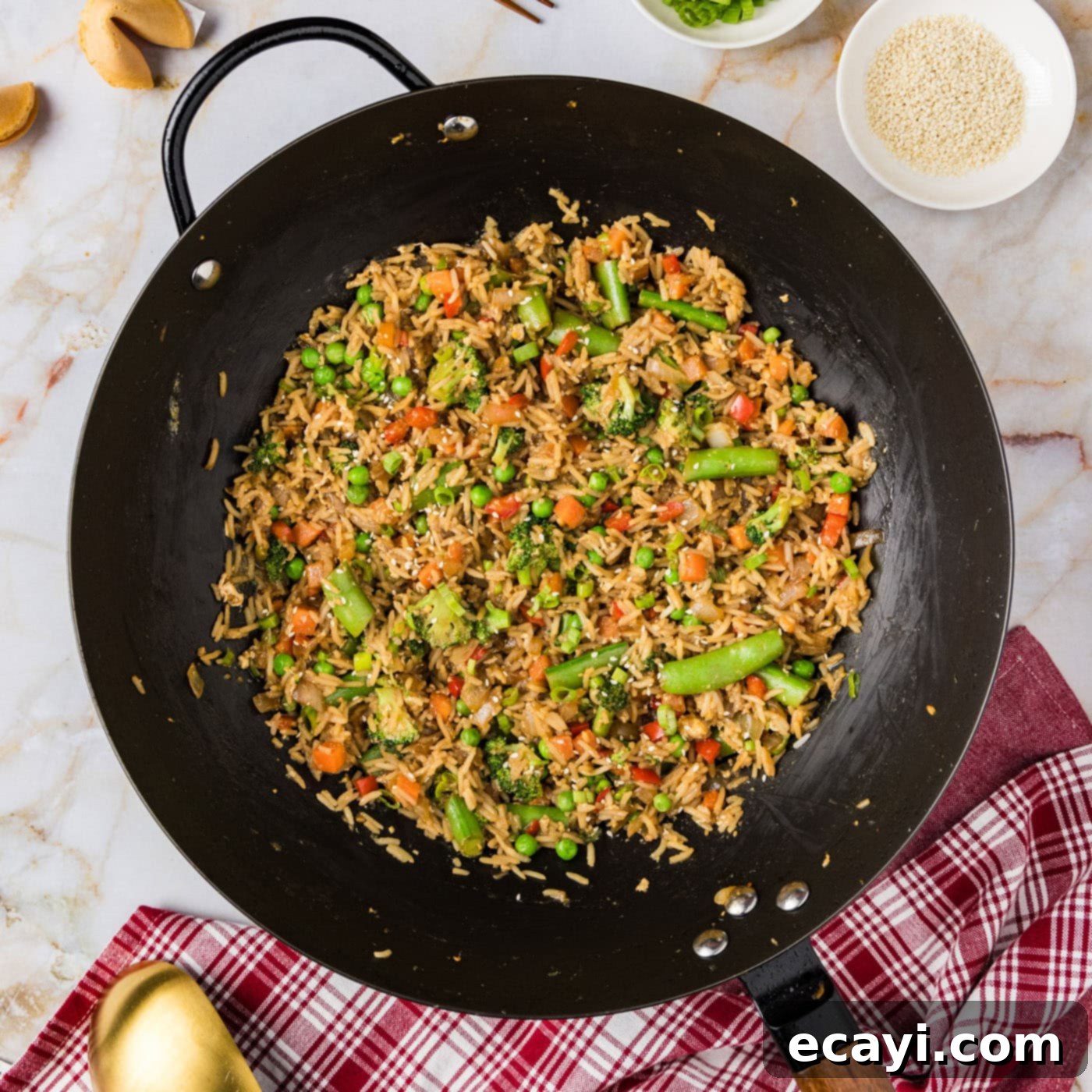Master the Art of Homemade Vegetable Fried Rice: An Easy & Flavorful Recipe
Embark on a culinary journey to create the ultimate homemade vegetable fried rice. This recipe isn’t just about combining ingredients; it’s a foolproof method to achieve a dish bursting with umami flavor, vibrant colors, and delightful textures. Forget greasy, takeout versions – this guide empowers you to whip up a stir-fry masterpiece in your own kitchen, packed with wholesome goodness and customizable to your heart’s content. Get ready to transform simple ingredients into an extraordinary meal that will impress everyone.
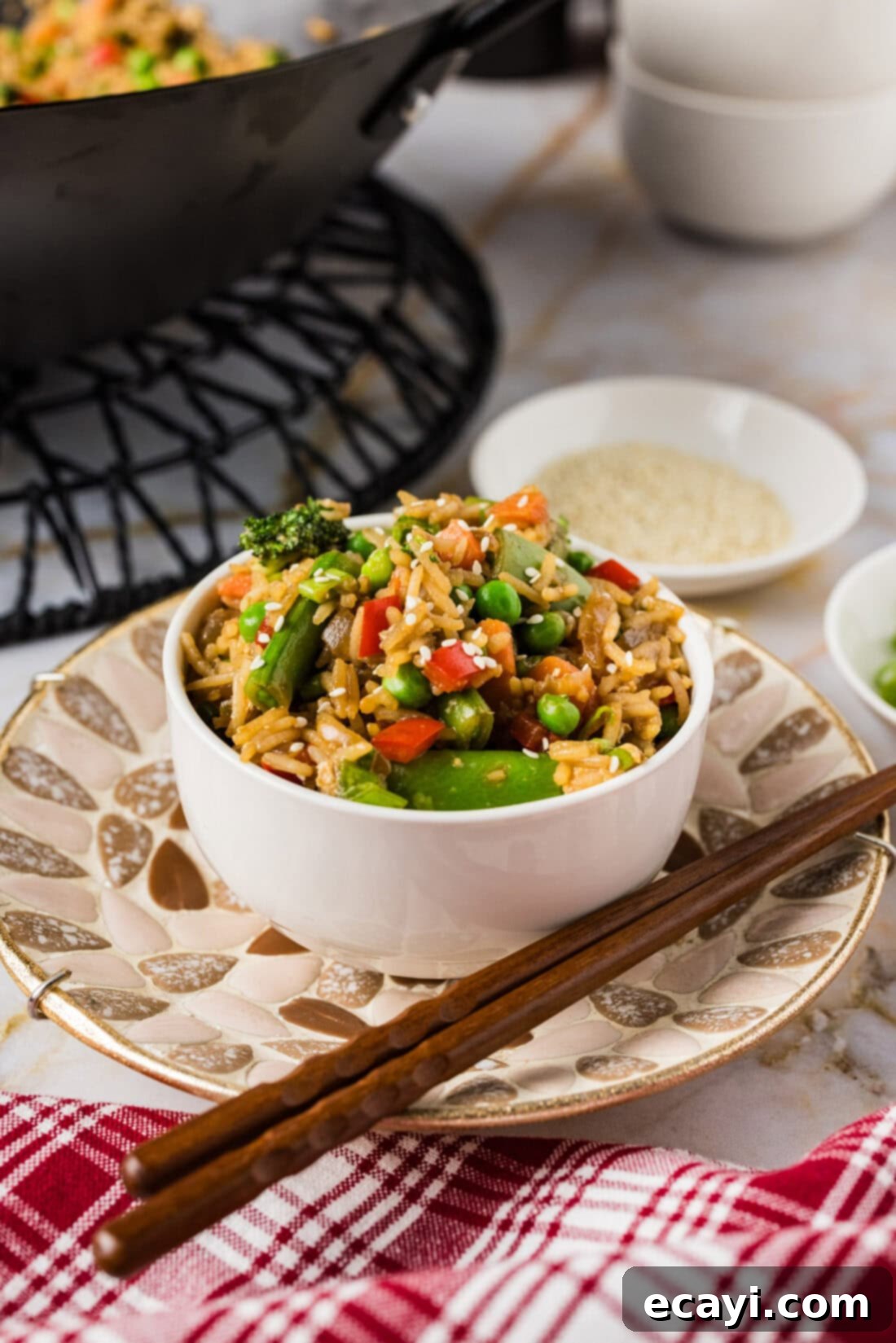
Why This Vegetable Fried Rice Recipe is a Must-Try
What makes this vegetable fried rice stand out? It’s all about intelligent techniques and a harmonious blend of authentic Asian flavors. The secret to perfectly textured fried rice lies in using **chilled leftover rice**, a simple yet crucial tip that prevents sogginess and ensures each grain gets beautifully crisp. This foundational element makes the cooking process remarkably easier, allowing you to focus on developing those rich, savory notes. Our recipe leverages the power of classic Asian condiments: rich **oyster sauce**, fragrant **toasted sesame oil**, and savory **soy sauce**. These ingredients aren’t just additions; they are the backbone of the umami punch that defines truly great fried rice, creating a depth of flavor that is both comforting and exciting. Beyond its incredible taste, this recipe is incredibly versatile. It serves as an excellent base for adding your favorite proteins, easily transforming into pork fried rice, shrimp fried rice, or even chicken or tofu variations. Whether you’re looking for a quick weeknight dinner, a healthy side dish, or a way to repurpose leftovers, this vegetable fried rice recipe is your new go-to. Let’s dive into the details and discover how effortlessly you can achieve culinary excellence.
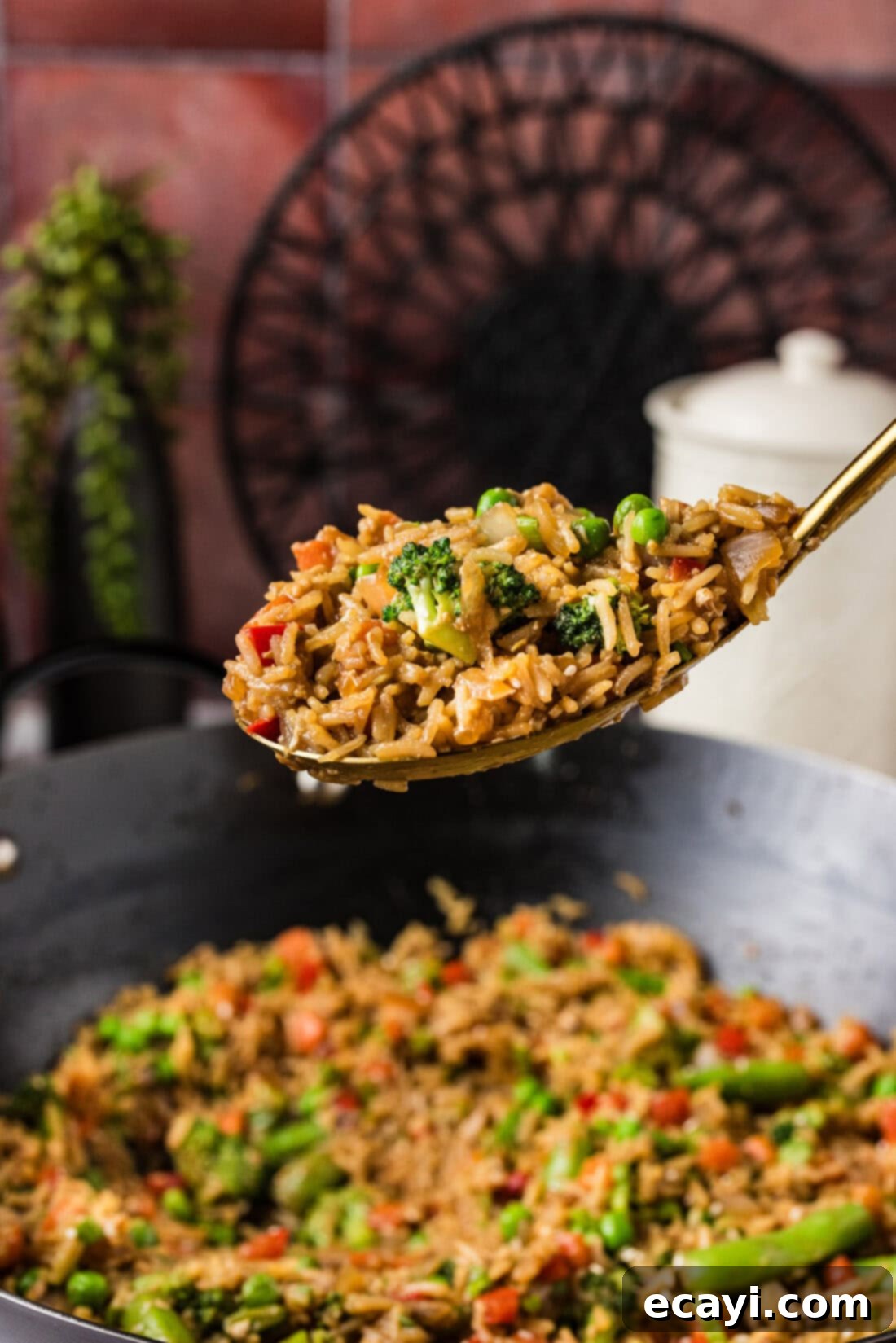
Gather Your Ingredients for Vibrant Fried Rice
To embark on this delightful culinary adventure, you’ll need a selection of fresh vegetables, essential flavor enhancers, and, of course, the star of the show: rice. While we’ll provide detailed information and substitution suggestions below, you can find all precise measurements and comprehensive instructions in the printable recipe card at the very end of this post. Having your ingredients prepped and ready (a technique known as ‘mise en place’) will ensure a smooth and enjoyable cooking experience, as fried rice comes together quickly once you start stir-frying!
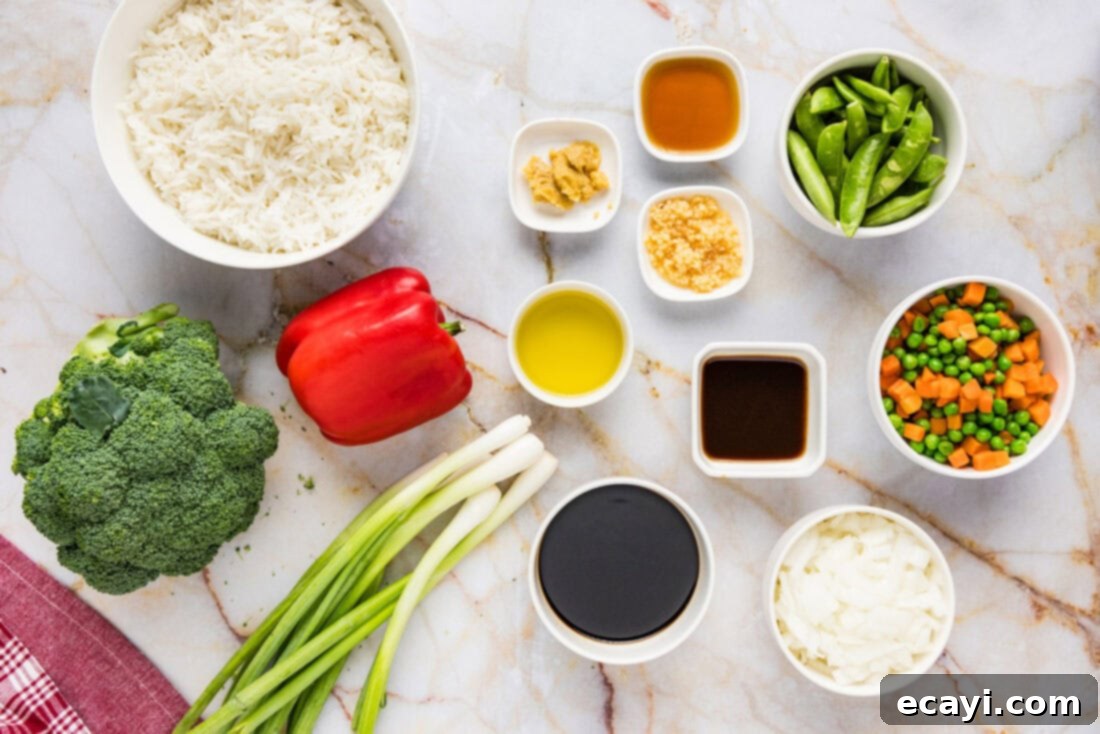
Ingredient Insights & Clever Substitutions
Understanding each ingredient’s role allows for mastery and creative freedom in your cooking. Here’s a deeper look into the components of our vegetable fried rice:
RICE – The bedrock of any great fried rice is, well, the rice! This recipe truly shines with **leftover chilled white rice**. The cooling process transforms the starch molecules, making the rice grains firmer and less prone to clumping or becoming mushy when they hit the hot wok. This results in that desirable slightly crispy texture. If you don’t have leftover rice, you can cook approximately 1 1/2 cups of raw white rice (like Jasmine or long-grain white rice) to yield the 4 cups of cooked rice needed. After cooking, spread it out on a baking sheet and refrigerate it for at least 30 minutes, or ideally a few hours, to achieve that crucial chilled state. Absolutely avoid using freshly cooked, warm rice, as it will steam rather than fry, leading to a gluey mess.
VEGETABLES – Our chosen medley for this recipe includes vibrant **broccoli florets**, finely diced **onion**, colorful **bell pepper** (red for sweetness and visual appeal), and crisp **snap peas**. We also add a convenient mix of **frozen peas and carrots**. The beauty of vegetable fried rice is its adaptability. Feel free to incorporate your personal favorites or whatever you have on hand! Other fantastic options include mushrooms, corn, baby corn, water chestnuts, bok choy, or cabbage. If using fresh vegetables that require more cooking time (like denser carrots or tougher greens), be sure to sauté them until they are tender-crisp before adding the softer vegetables to the wok.
FLAVOR BOOSTERS (Ginger & Garlic) – Freshly minced **ginger** and **garlic** are non-negotiable for authentic Asian flavors. They provide an aromatic foundation that permeates the entire dish. Don’t skimp on these; their pungent and spicy notes are essential. If fresh isn’t available, ginger paste or garlic paste can be used in a pinch, though fresh is always preferred for maximum impact.
UMAMI SAUCES (Soy Sauce & Oyster Sauce) – These are the cornerstone of the savory, umami-rich profile. We use **soy sauce** for its salty depth and to coat the rice. For dietary restrictions, low-sodium soy sauce or tamari (for gluten-free) are excellent alternatives. **Oyster sauce** adds a unique, slightly sweet, and incredibly rich umami dimension. If you’re vegetarian or vegan, look for mushroom-based vegetarian oyster sauce, which offers a similar depth of flavor. If you prefer not to use oyster sauce, you can increase the soy sauce slightly and add a dash of sugar or a few drops of dark soy sauce for color and a touch of sweetness.
TOASTED SESAME OIL – This is your finishing oil, imparting a distinctive nutty aroma that is characteristic of many Asian dishes. It’s usually added at the very end to preserve its delicate flavor. A little goes a long way!
EGG – A single large **egg**, scrambled directly in the wok, adds richness, texture, and a touch of protein. It’s a classic component of fried rice. If you prefer to omit it, the recipe will still be delicious; just ensure you have enough other vegetables.
GARNISH (Green Onions) – Sliced **green onions** provide a fresh, pungent finish and a pop of color. They’re typically stirred in at the very end or used as a garnish.
How to Craft Your Delicious Vegetable Fried Rice
These detailed step-by-step photos and instructions are designed to help you visualize each stage of making this incredibly satisfying dish. For a convenient, printable version of this recipe, complete with precise measurements and concise instructions, simply Jump to Recipe at the bottom of this page. We’ll guide you through each part, ensuring your homemade fried rice is a resounding success!
- Prepare Your Wok: Heat 2 Tablespoons of vegetable oil in a wok or a large, heavy-bottomed skillet over medium-high heat. Wait until the oil is shimmering, indicating it’s hot enough to stir-fry effectively without making the vegetables soggy.
- Aromatics First: Add the minced ginger and minced garlic to the hot oil. Stir fry vigorously for about one minute, or until they become wonderfully fragrant. Be careful not to burn the garlic, as it can turn bitter quickly. This step creates the aromatic base for your fried rice.
- Stir-fry Fresh Vegetables: Introduce the harder vegetables: chopped onion, snap peas, broccoli florets, and chopped red bell pepper. Stir-fry these for 1-2 minutes. The goal is for them to become tender-crisp, maintaining some of their bite and vibrant color.
- First Sauce Infusion: Add 1/4 cup of the soy sauce and 1 Tablespoon of the oyster sauce to the vegetables. Continue to stir-fry, ensuring everything is well combined and coated in these flavorful sauces. This infusion of flavor begins early in the cooking process.
- Introduce Rice and Egg: Add the chilled cooked rice to the wok. Toss and stir everything together thoroughly, breaking up any clumps of rice so that each grain is separated and coated. Once combined, push all the ingredients to one side of the wok, creating a clear space. Crack the egg directly into this cleared area and quickly scramble it until just cooked. Then, mix the scrambled egg with the rest of the rice and vegetables, distributing it evenly throughout the dish.
- Final Flavor Boost: Now, add the frozen peas and carrots (no need to thaw), the remaining 1/4 cup of soy sauce, the remaining 1 Tablespoon of oyster sauce, and the fragrant sesame oil. Toss everything together vigorously, ensuring all ingredients are well combined and evenly heated. The rice should take on a golden hue and a slightly dry, fried texture.
- Garnish and Serve: Finally, toss in the freshly sliced green onions. Stir briefly to incorporate them, adding a fresh, zesty finish. Serve your homemade vegetable fried rice immediately, either as a standalone meal or a delightful side dish.
Frequently Asked Questions & Expert Tips for Perfect Fried Rice
Using chilled, day-old rice is perhaps the most critical tip for achieving restaurant-quality fried rice. When cooked rice is allowed to cool and chill, it undergoes a process called retrogradation, where the starch molecules recrystallize. This makes the individual grains firmer, drier, and less sticky. When these dry, firm grains hit a hot wok, they can actually fry and get slightly crispy, rather than clumping together and steaming, which results in a mushy, unappealing texture. If you use warm, freshly cooked rice, it contains too much moisture, preventing it from truly frying. So, plan ahead for the best results!
Store any leftover vegetable fried rice in an airtight container in the refrigerator for up to 3 days. To reheat, you have a couple of excellent options. For best results, reheat it in a skillet over medium heat with a tiny splash of oil, stirring occasionally until heated through. This helps to re-crisp the rice grains. Alternatively, you can use a microwave, placing the fried rice in a microwave-safe dish and covering it loosely. Optionally, add a splash of water or a few ice cubes on top before microwaving to create some steam, which helps remoisten the rice and prevents it from drying out. Heat in short bursts, stirring in between, until piping hot.
While long-grain white rice (like Jasmine or Basmati) is traditional and works best due to its lower starch content, you can experiment. Brown rice can be used, but it will have a chewier texture and might require slightly more oil to prevent sticking. Sushi rice or other short-grain sticky rice varieties are generally not recommended, as they tend to clump excessively even when chilled.
A large wok is ideal for making fried rice because its sloped sides allow for easy tossing and even heat distribution, facilitating quick cooking. If you don’t have a wok, a large, heavy-bottomed skillet or a cast-iron pan will also work well. The key is to use a pan that can get very hot and retain heat, and that is spacious enough to stir-fry all your ingredients without overcrowding.
This recipe is incredibly versatile! Feel free to add or swap out vegetables based on seasonality and preference. Good options include mushrooms, corn, shredded cabbage, bean sprouts, or bamboo shoots. For protein, cooked chicken, pork, shrimp, beef, or even tofu can be added. If adding raw protein, cook it first in the wok, remove it, and then add it back in with the rice at step 5. This ensures even cooking and prevents overcrowding.
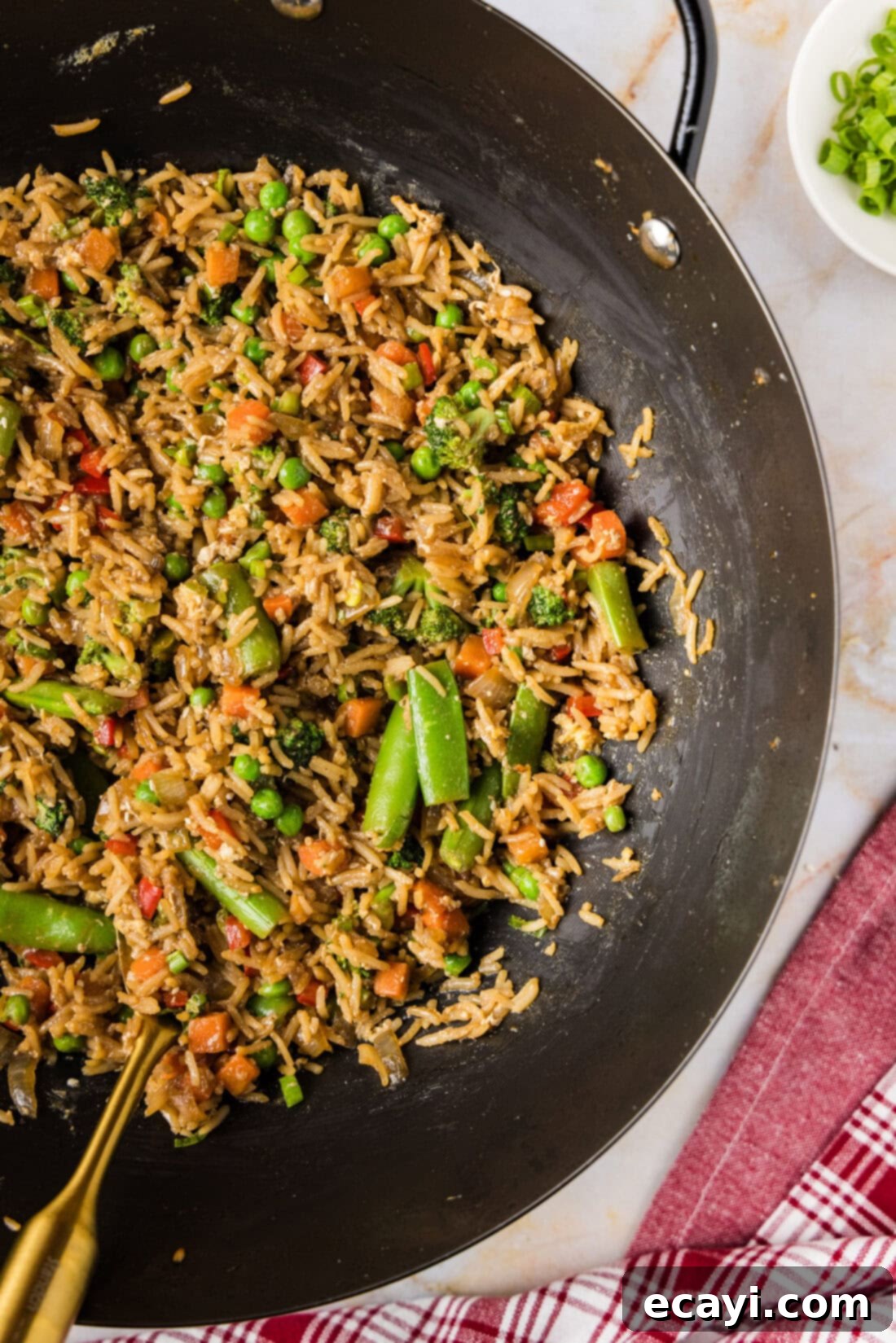
Delightful Serving Suggestions
Vegetable fried rice is a wonderfully versatile dish that can be enjoyed in countless ways. It makes a fantastic standalone light meal, packed with flavor and nutrients. Alternatively, it serves as a superb and colorful side dish, complementing a wide array of Asian-inspired main courses. Pair it with succulent grilled teriyaki chicken, savory stir-fried beef, crispy tofu, or perfectly cooked shrimp for a complete and satisfying dinner. To elevate the experience, consider topping your fried rice with a drizzle of extra soy sauce, a dollop of sweet duck sauce, or a fiery dash of sriracha for those who enjoy a little heat. A generous sprinkle of freshly sliced green onions as a garnish adds a burst of freshness and visual appeal, making your dish not only taste incredible but also look professionally prepared.
Explore More Delicious Fried Rice Recipes
If you’ve fallen in love with the ease and flavor of this vegetable fried rice, you’ll be thrilled to discover the endless possibilities within the world of fried rice. From rich and savory to sweet and tangy, there’s a fried rice variation for every palate. Expand your culinary repertoire with these other fantastic recipes:
- Shrimp Fried Rice: A seafood lover’s delight, packed with plump shrimp.
- Chicken Fried Rice: A classic and comforting staple, perfect for any occasion.
- Pineapple Fried Rice: A sweet and savory tropical twist that’s surprisingly refreshing.
- Cauliflower Fried Rice: A low-carb, vegetable-packed alternative that doesn’t compromise on flavor.
- Korean Fried Rice: A bolder, spicier version featuring gochujang and other Korean flavors.
I’m passionate about sharing my kitchen adventures and delicious recipes with all of you! To make sure you never miss a new culinary creation, I offer a convenient newsletter delivered straight to your inbox every time a new recipe posts. Simply subscribe and start receiving your free daily recipes to inspire your cooking!
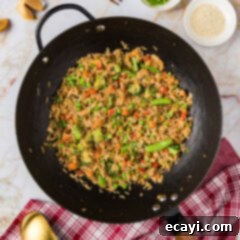
Vegetable Fried Rice
IMPORTANT – There are often Frequently Asked Questions within the blog post that you may find helpful. Simply scroll back up to read them!
Print It
Pin It
Rate It
Save ItSaved!
Ingredients
- 2 Tablespoons vegetable oil for stir-frying
- 2 teaspoons minced ginger
- 1 Tablespoon minced garlic
- 1 cup chopped onion
- 1 cup snap peas or snow peas
- 1 crown chopped broccoli about 1 cup florets
- ½ cup chopped red bell pepper
- ½ cup soy sauce
- 2 Tablespoons oyster sauce (or vegetarian oyster sauce)
- 4 cups cooked white rice (preferably day-old and chilled)
- 1 large egg lightly beaten
- ¾ cup frozen peas and carrots blend
- 2 teaspoons sesame oil
- ¼ cup chopped green onions for garnish
Things You’ll Need
-
Wok or large heavy bottomed skillet
-
Rubber spatula heat resistant
Before You Begin: Essential Tips for Success
- This recipe truly excels when using **leftover, chilled rice**. If you don’t have any, cook about 1 1/2 cups of raw white rice to yield the 4 cups needed, then spread it out and chill thoroughly in the refrigerator before starting. Fresh, warm rice will clump and become mushy, rather than frying properly.
- Chef Antoine recommends trimming the tough ends off snap peas for a more refined texture, but this step is entirely optional and depends on your preference.
- While frozen peas and carrots offer great convenience, feel free to use fresh alternatives. Just ensure any fresh, harder vegetables are sautéed until tender-crisp before adding to the wok.
Step-by-Step Instructions
-
Heat the vegetable oil in your wok or large skillet over medium-high heat until it’s shimmering and just about to smoke. This ensures your ingredients will sear rather than steam.2 Tablespoons vegetable oil
-
Add the minced ginger and garlic to the hot oil. Stir fry them rapidly for approximately one minute until a fragrant aroma fills your kitchen. Be careful not to let them burn.2 teaspoons minced ginger, 1 Tablespoon minced garlic
-
Add the chopped onion, snap peas, broccoli florets, and red bell pepper to the wok. Continue to stir fry for 1-2 minutes until the vegetables are tender-crisp and vibrant in color.1 cup chopped onion, 1 cup snap peas, 1 crown chopped broccoli, 1/2 cup chopped red bell pepper
-
Pour in 1/4 cup of the soy sauce and 1 Tablespoon of the oyster sauce. Stir fry just enough to coat and combine the vegetables with these savory liquids.
-
Add the chilled rice to the wok, tossing and stirring vigorously to break up any clumps and thoroughly combine it with the vegetables and sauces. Once mixed, push all ingredients to one side, creating a clear space. Pour the beaten egg into this space and quickly scramble it until cooked through. Immediately mix the scrambled egg into the fried rice, ensuring it’s evenly distributed.4 cups cooked white rice, 1 large egg
-
Now, add the frozen peas and carrots (no need to thaw), the remaining 1/4 cup soy sauce, the remaining 1 Tablespoon of oyster sauce, and the aromatic sesame oil. Toss everything together vigorously for a final stir-fry, ensuring all ingredients are well combined and heated through.3/4 cup frozen peas and carrots, 2 teaspoons sesame oil
-
Finally, gently toss in the sliced green onions. Stir them in briefly to maintain their fresh crunch and vibrant color. Serve your delicious vegetable fried rice immediately and enjoy!1/4 cup chopped green onions
Expert Tips & FAQs for Optimal Results
- For storing, keep leftover vegetable fried rice in an airtight container in the refrigerator for up to 3 days. When reheating in a skillet or microwave, a small splash of water can help remoisten the rice, keeping it from drying out.
- To achieve a truly authentic stir-fry flavor, ensure your wok (or skillet) is smoking hot before adding any ingredients. This high heat is key to quick cooking and preventing a soggy outcome.
- Don’t overcrowd the pan! If you’re making a larger batch, it’s better to cook the fried rice in two separate batches. Overcrowding lowers the pan’s temperature and steams the ingredients instead of frying them.
Nutrition Information
The recipes on this blog are meticulously tested with a conventional gas oven and gas stovetop to ensure consistent results. Please note that oven performance can vary, especially with older models, so an inexpensive oven thermometer can be a valuable tool to verify accurate temperatures. If you’re using a toaster oven or a countertop oven, be aware that their heat distribution might differ from full-sized ovens, potentially requiring adjustments to cooking and baking times. For recipes prepared with specific appliances like pressure cookers, air fryers, or slow cookers, links to the models we use are provided within their respective recipes. For baking recipes where ingredients are measured by weight, we highly recommend adhering to these measurements, as using volumetric cups can lead to inconsistent outcomes, and we cannot guarantee success with such substitutions.
